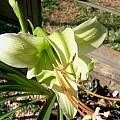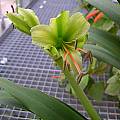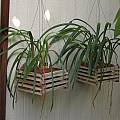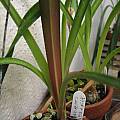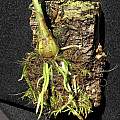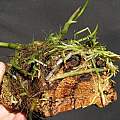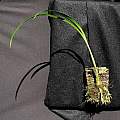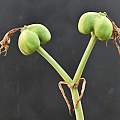Quick Characteristics:
| Flower Colors: | green |
Hippeastrum calyptratum (Ker Gawl.) Herb. is an unusual member of the genus. Pollinated by bats, this interesting species' green flowers emit an unusual odour said to be similar to that of burnt plastic. The bulbs grow as epiphytes attached to mossy trees, or grow as lithophytes on rock surfaces in bright light at around 1200 m elevation (4000') in the Serra dos Órgãos (Organ Mountains) within the highly endangered eco-region of the Mata Atlântica (Atlantic Forest) of Brazil. Occasionally they are also found growing in shade. Flowering occurs in late autumn.
Its cultivation is considered by some to be challenging and this is because as an epiphyte, its needs are much different than that of most geophytes. It helps to think of it as an orchid. The species is best grown under cool or intermediate conditions (max 85 °F/30 °C, min 45 °F/7 °C). Bright, filtered sun or part-shade and humidity above 60% is recommended. It is often grown as a potted plant with its basal plate just below the surface of the potting media. The potting media should be very open, coarse, and well-drained (similar to potting media used for many types of epiphytic or lithophytic plants such as orchids), but it can also be grown mounted to wood or cork oak bark mount if provided ambient humidity above 75% r/h. The potting media shouldn't retain too much moisture or decompose too quickly because it will cause the roots and bulbs to rot. Its roots like to dry out quickly between waterings but also don't like to stay dry for long. Like most amaryllids and epiphytes, it resents root disturbance and may sulk for some time after being repotted. For this reason its potting media should be durable. Nhu Nguyen has found that they grow well in pure horticultural pumice. Uluwehi Knecht has grown this species from seed sown directly into a medium of equal parts 0.5-1 cm chunks of diatomite, black cinder (scoria), and horticultural charcoal.
The first photo shows a plant grown from seed by Rogan Roth and photographed by Digby Boswell. The next two pictures are of plants grown and photographed by Johannes-Ulrich Urban. The plant in the background is Sinningia magnifica. The fourth and fifth pictures were taken by Nhu Nguyen of seedlings grown by Uluwehi Knecht in Honolulu, Hawai'i from seed sown in small terracotta pots. They are 1.5 years old and some have developed their bulbs faster than others. Many of the seedlings have red-emergent leaves that fade to dark green as seen in the 5th picture.
The first three photos below were photographed and grown as a mounted seedling by Uluwehi Knecht. A very humid environment is necessary for this method to be successful. The last photo from Gianluca Corazza show the results of self pollination. Fruits are over 6 cm in diameter.
